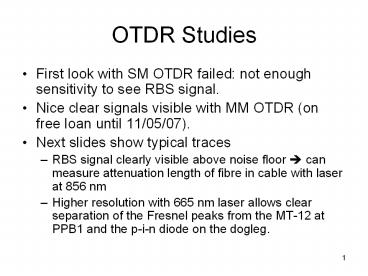OTDR Studies - PowerPoint PPT Presentation
Title:
OTDR Studies
Description:
RBS signal clearly visible above noise floor can measure attenuation length of ... nm laser allows clear separation of the Fresnel peaks from the MT-12 at PPB1 and ... – PowerPoint PPT presentation
Number of Views:1803
Avg rating:3.0/5.0
Title: OTDR Studies
1
OTDR Studies
- First look with SM OTDR failed not enough
sensitivity to see RBS signal. - Nice clear signals visible with MM OTDR (on free
loan until 11/05/07). - Next slides show typical traces
- RBS signal clearly visible above noise floor ?
can measure attenuation length of fibre in cable
with laser at 856 nm - Higher resolution with 665 nm laser allows clear
separation of the Fresnel peaks from the MT-12 at
PPB1 and the p-i-n diode on the dogleg.
2
OTDR Measurements
APC
ST
MT
MT
MM v OTDR
3.2m or 2m
5m
MT
p-i-n diode
FUT (Fibre under test)
2m
3
MT-12 at PPB1
Connectors at start of cable and fan-out
RBS Signal above background
p-i-n diode on dogleg
4
Use delay setting to avoid peaks from start of
cable fan-out
5
Use 665 nm laser for higher resolution to see
loss at MT-12 at PPB1
6
Use 856 nm laser to measure attenuation length of
fibre in cable
7
Measurements
- Measured attenuation length of fibres in cable
and loss at MT-12 at PPB1 for - All fibres in 4 ribbons associated with
problematic channels, all channels have lt 90 mA
p-i-n current. - All fibres in 4 ribbons associated with good
channels. All channels have gt 90 mA p-i-n
current. - Also checked that there was no excess loss near
PPB1 due to micro-bending. - Measured attenuation length of 4 ribbons in spare
cable.
8
Summary
- Attenuation lengths
- ltgood channelsgt 15.1 /- 0.45 dB/km
- ltbad channelsgt 17.1 /- 0.6 dB/km
- ltfibres spare cablegt 8.24 /- 0.28 dB/km
- Loss at MT-12 PPB1
- ltgood channelsgt 0.13 /- 0.02 dB
- ltbad channelsgt 0.17 /- 0.03 dB
9
Discussion
- There are systematic errors on the absolute
values of these measurements but the relative
measurements of good and problematic channels
should be meaningful. - Losses at PPB1 appear to be very small and no
significant difference between problematic and
good channels. - The attenuation length for problematic channels
is slightly longer than for good channels.
Marginally statistically significant (2.7 s) - Attenuation length for fibes in spare cables is
significantly longer.
10
Averages for ribbons
- Look at average attenuation lengths for each
ribbon - Good
- Problematic
- Spare
Crate/slot/Tx Attenuation dB/km Error
0 8 0 10.55 0.35
2 14 1 15.06 0.54
1 7 1 17.58 0.32
3 15 0 17.14 0.27
Crate/slot/Tx Attenuation dB/km Error
0 6 0 15.38 0.60
0 7 0 12.71 1.34
2 12 0 18.83 0.15
2 12 1 21.63 0.50
11
Conclusions
- Some evidence for non-statistical ribbon to
ribbon variations. - Difference between good and problematic
ribbons small, even for worst ribbon - extra attenuation compared to good ribbons is
only 0.6 dB. - For this ribbon ltExpected/measured pin currentgt
5.9 dB - Difference between fibre in spare cable and
fibres in installed cables is much larger. - Different mode coupling for fibres in installed
cables compared to fibres in spare cable ??? - Still need better VCSELs































